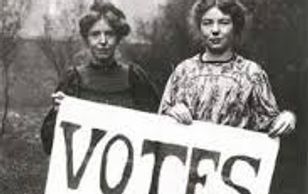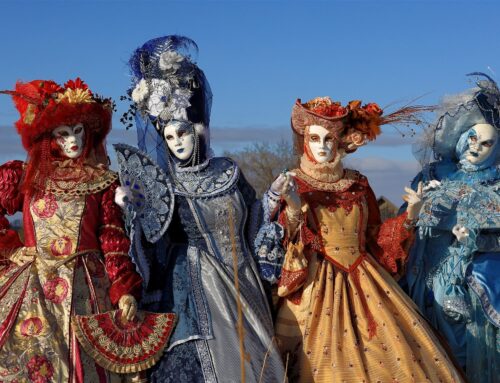Almost 100 years ago, American women were finally granted the Constitutional right to vote in elections, known as the right of suffrage. It took many years of protest to achieve that right, and women are still working today to ratify the Equal Rights Amendment.
Looking back to 1776, the Declaration of Independence declared that “all men are created equal.” As John Adams worked to create the new country’s laws, his wife, Abigail, urged him to give more rights to women. John Adams replied, “We know better than to repeal our Masculine systems,” adding wryly that women typically ruled most Colonial homes.
After the American Revolution ended in 1783, the law still dictated that when a woman married, she lost her legal identify. Women could not own property, control their own money, sign legal documents, or have any say in politics.
As more states were added to the union, many women “found their voices” and the women’s suffrage movement grew. In the early 1800s, women led a variety of reform groups, and started rebelling against the role of submissive wife.
In 1848, reformers Elizabeth Cady Stanton and Lucretia Mott organized the first women’s rights convention at Seneca Falls, N.Y., attended by more than 300 people – mostly women. Their discussions focused on better opportunities for education, employment – and political identities.
Staten Island had an important role in the women’s suffrage movement. Cara Dellatte, archivist at the Staten Island Museum, wrote an article for the Staten Island Advance detailing some suffrage events that took place on the island during the early 1900s.
One of the largest was held at the 1910 Richmond County Fair, when hundreds of women – including some from other states – gathered in a large tent to hear speeches aimed at making them more informed citizens. A New York Times article stated that the suffrage tent was more popular than the fair’s horse racing events.
According to Dellatte, Staten Island had “many more suffrage-related events” including a plan to drop petitions from women on President Woodrow Wilson while he was visiting New York City in 1916. “Leda Richberg-Hornsby was to fly her plane from Midland Beach and drop leaflets on Wilson’s yacht … as it traveled down the Hudson,” Dellatte wrote, but high winds spoiled the mission and Richberg-Hornsby had to crash land the plane in a Staten Island swamp, suffering only some bumps.
In 1918, Wilson ultimately switched his stand on women’s voting rights from objection to support. On Aug. 26, 1920, the 19th Amendment was certified by U.S. Secretary of State Bainbridge Colby, and U.S. women finally achieved the long-sought right to vote. Later that year in November, more than 8 million U.S. women voted in elections for the first time. It took over 60 years for the 12 remaining states to ratify the 19th Amendment; Mississippi became the last in 1984.
Today, women are still struggling to have the Equal Rights Amendment (ERA) added to the U.S. Constitution. It would guarantee equal legal rights for all American citizens regardless of sex, and end legal distinctions between men and women in terms of divorce, property, employment, and other matters.
Supporters of the ERA worked hard from 1972 to 1982 by lobbying, picketing, petitioning – even going on hunger strikes. Recently, because of the Me Too movement, interest in the ERA has been revived. In January, Virginia became the 38th state to ratify the ERA.
Last year, Casa Belvedere was one of 20 historic American sites to win a share of $2 million in preservation funding from American Express. The 2019 Partners in Preservation: Main Streets program was held in collaboration with the National Trust for Historic Preservation and Main Street America. The competition placed special emphasis on historic buildings and sites that celebrate the contributions of women in communities across America to honor the upcoming 100th anniversary of the ratification of the 19th Amendment, guaranteeing women the right to vote.
Casa Belvedere’s entry focused on the original Grymes Hill home built in 1908 by silk merchants Louis and Laura Roebling-Methfessel-Stirn. Other notable “women of steel” who had strong ties to the Stirn Mansion were Suzette Cole-Claiborne-Grymes and Emily Warren-Roebling. Their contributions helped shape Staten Island, the Brooklyn Bridge and ultimately the United States.
In 2009, Gina Biancardi reclaimed the long abandoned and neglected Stirn Mansion and began to resuscitate and transform it into Casa Belvedere, today a nonprofit arts and cultural center.
Suffrage in Italy
In Italy, women received the right to vote almost 25 years after women in the United States. The film documentary Senza Rossetto translates to “without lipstick” and references the time when Italian women were told to go to the polls and vote without wearing lipstick. If traces of lipstick were found on an election card, it could be invalidated.
In 1945, Italian women were given the right to vote in elections. In 1946, they obtained the right to be elected.
Want to learn more? Click here for a special video presentation on this subject.
The Italian Cultural Foundation at Casa Belvedere is a not-for-profit organization that celebrates everything Italian by sharing stories such as this, and offering exceptional public programs: Language and cooking classes; art and photo exhibits; film festivals; opera luncheons and casino nights; Italian car shows and fashion shows; live concerts and theatrical performances; guest chef experiences and wine tastings; bocce and bingo (tombola); and much more. Casa Belvedere (house with a beautiful view) has established itself as a vibrant and buzzing cultural center in New York City. For more information, visit casa-belvedere.org.







